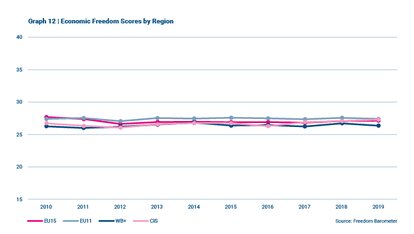Freedom Trends
Economic Freedom: 10 Years of Freedom Barometer

Economic Freedom
©The cornerstones of economic freedom are personal choice, voluntary exchange, freedom to enter and compete in a market, and the security of a person and privately owned property. According to Freedom Barometer, economic freedom is measured through four broad categories:
- Security of Property Rights
- Size of Government
- Freedom to Trade Internationally
- Regulation of Credit, Labour and Business.
THERE ARE STRONG CONNECTIONS BETWEEN ECONOMIC FREEDOM AND A SET OF POSITIVE VARIABLES.
Multiple studies have shown a statistically significant connection between economic freedom and a rich set of positive variables, such as higher economic growth, per capita income, healthcare, and education outcomes such as longevity, literacy rates etc. At the same time, there is no correlation between economic freedom and negative variables, not even with inequality. The connections with political and institutional variables are less clear, but the fact that there are no democracies with a low level of economic freedom is telling.

Economic Freedom Scores by Region
THERE ARE NO DEMOCRACIES WITH A LOW LEVEL OF ECONOMIC FREEDOM.
At the first glance, there is virtually no regional difference in the level of economic freedom among European countries. This looks like a great victory of transition – now on average, transition countries from the former COMECON have reached the same level of economic freedom as advanced market economies.
ALTHOUGH ECONOMIC FREEDOM IS AT A SIMILAR LEVEL ACROSS REGIONS, THERE ARE DEEPER, UNDERLYING DIFFERENCES.
But after a deeper inspection, there are deep, underlying differences that are hidden below the surface: even though the total number of points is the same, the distribution of scores across categories is not. EU15 countries have a significantly lower score in the Size of Government section, and a significantly higher score in the Security of Property Rights section, compared to other countries. Therefore, this difference grows with geographical and political distance – it is more pronounced in WB+ or CIS countries than in the EU11, which supports the theory of institutional convergence within the EU. It seems that if one wants to have secure property rights, then it need be paid with higher taxes to support the welfare state.
SECURE PROPERTY RIGHTS SEEM TO GO HAND IN HAND WITH THE WELFARE STATE.
The level of economic freedom achieved is a consequence of the dominant social order. Therefore, it is clear why the level of economic freedom has stayed roughly the same during the previous decade. For a significant and sustainable increase (or decrease) in economic freedom, the underlying assumptions are the changes in the power status and structures of prominent social groups. These “dominant coalitions’’ are often in flux, but the underlying principles of their organization and function are mostly durable. Therefore, there is an elaborate interplay between institutional settings, political organizations and economic freedoms.
THE LEVEL OF ECONOMIC FREEDOM IS A CONSEQUENCE OF THE DOMINANT SOCIAL ORDER.
Without these deeper changes, reforms that aim at increasing economic freedom end up ineffective since they change only the formal rules of the games while the informal ones remain the same. Also, that is why intervention from outside stakeholders (such as the IMF, the WB, or the EU) in promoting institutional development may not work as envisaged, since these need to rely on local stakeholders.

Changes in the Economic Freedom Score by Country
CHANGING FORMAL RULES DOES NOT CHANGE THE INFORMAL ONES.
There are several trends that pose challenges to the current economic order, and thus the current level of economic freedom. The rise of populism in politics poses a danger to institutions and the rule of law through reducing their independence from the centre of political authority, in fact dismantling the existing checks and balances. This could lead to a much stronger executive power which could be used to curtail property rights of those with little political importance. This problem also relates to the regulatory burden and its uneven application on different sectors and companies due to state capture. The wave of global trade protectionism has so far been restricted to the US and its trade relations with China, but the long-term impact of the Covid-19 pandemic could create a new momentum. Demographic changes through increasing expenses for retirement benefits and healthcare pose long-term threats to government solvency since most countries already face high public debt and new needs for financing the Covid-19 induced recession. The development of AI and automation could also add pressure for higher public spending for displaced workers or the population as a whole through UBI schemes. Some of these seem to be insurmountable obstacles, but there are also opportunities: cheaper and better technology that will change the way we work, communicate and travel, and the possibility of institutional change and adaptation. But these XXI century problems will not be easily cured with XX century remedies: for new solutions we also need a new vision.
-
Download the full report